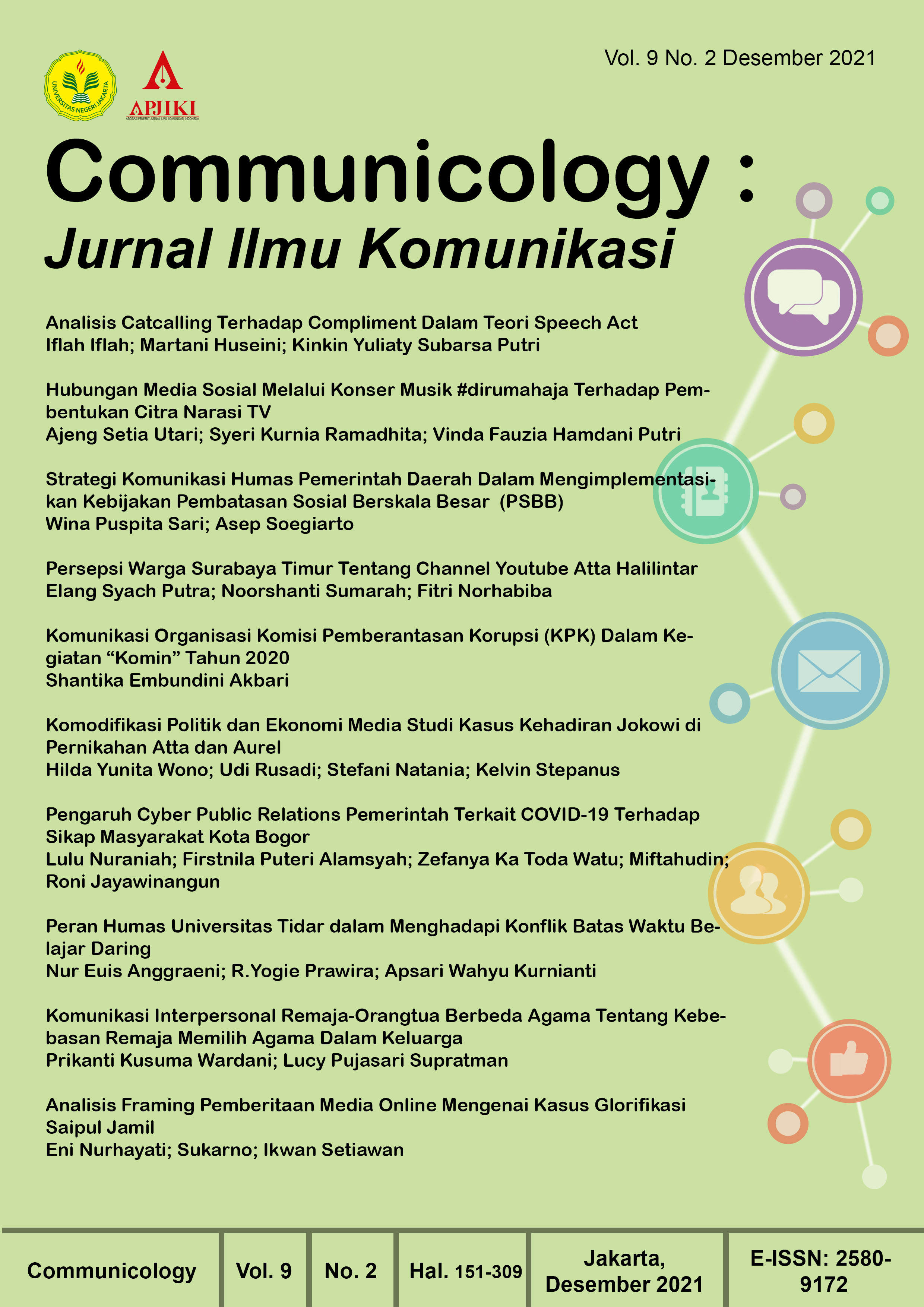Peran Humas Universitas Tidar dalam Menghadapi Konflik Batas Waktu Belajar Daring
DOI:
https://doi.org/10.21009/COMMUNICOLOGY.022.08Keywords:
Peran Humas, Strategi HumasAbstract
ABSTRACT
This study discusses how public relations at Tidar University in dealing with online learning time limit conflicts. The purpose of this study was to examine the role of Tidar University Public Relations in dealing with online learning time limit conflicts. This study uses a qualitative approach because the researcher intends to investigate the role of public relations more deeply, which cannot be explained in statistics. The method used is a case study conducted by collecting in-depth and detailed data that includes several sources of information through interviews. The results of the study found that the role of Tidar University's public relations officer was as a communication technician and a communication facilitator. The communication strategy used in dealing with online learning time limit conflicts is mediation carried out by the leadership, bridged by public relations. After that, public relations get the results of mediation for general information needs.
Keywords: Conflict; Public Relations Role; Strategy Public Relations
ABSTRAK
Penelitian ini membahas tentang bagaimana peran humas Universitas Tidar dalam menghadapi konflik batas waktu belajar daring. Tujuan penelitian ini adalah mengkaji peran Humas Universitas Tidar dalam menghadapi konflik batas waktu belajar daring. Penelitian ini menggunakan pendekatan kualitatif karena peneliti bermaksud untuk mengkaji lebih dalam mengenai peran humas yang tidak bisa dijelaskan dalam angka statistik. Metode yang digunakan adalah studi kasus yang dilakukan dengan mengumpulkan data secara mendalam dan detail yang menyertakan beberapa sumber informasi melalui wawancara. Hasil penelitian didapatkan bahwa peran humas Universitas Tidar adalah sebagai teknisi komunikasi dan fasilitator komunikasi. Strategi komunikasi yang digunakan dalam menghadapi konflik batas waktu belajar daring adalah mediasi yang dilakukan oleh pimpinan, dengan dijembatani oleh humas. Setelah itu, humas mendapatkan hasil mediasi untuk kebutuhan informasi publik.
Kata Kunci: Konflik; Peran Humas; Strategi Humas
References
Creswell, J. W. (2015). Penelitian Kualitatif & Desain Riset. Pustaka Pelajar.
Ebeguki, I. E., Omotayo, O. A., & Paul, S. O. (2016). Strategic Communication as a Means of Resolving Conflict among Academics in the Nigerian Public Universities. International Journal of Social Sciences & Educational Studies, 3(2), 61–72.
Effendy, O. U. (2011). Ilmu Komunikasi: Teori dan Praktek. PT. Remaja Rosdakarya.
Fauziah, F. (2015). Peran Hubungan Masyarakat (Humas) Forum Betawi Rempug (FBR) dalam Mengatasi Krisis. UIN Syarif Hidayatullah.
Gandariani, T. (2019). Perencanaan Krisis Pr : Sebuah Upaya Strategi. Lentera Komunikasi, 3(November), 44–56.
Harivaman, D. (2017). Hambatan Komunikasi Internal di Organisasi Pemerintahan. ASPIKOM, 3, 508–519.
Kindangen, E. F., Mew2engkang, N. N., & Harilama, S. (2015). Penerapan Fungsi Humas Sesuai Struktur Organisasi Perusahaan (Studi Di Hotel Gran-Puri Manado). Acta Diurna, IV, 8.
Nurjanah. (2017). Strategi Komunikasi Organisasi Humas Dalam Menyelesaikan Konflik Antarumat Beragama (Studi Pada Kantor Bupati Aceh Singkil). UIN Sumatera Utara.
Seta, P. M. (2014). Strategi Komunikasi PT. Kaha Event Management Dalam Mempertahankan Loyalitas Pelanggan. 25.
Sugiyono. (2014). Metode Penelitian Kuantitatif, Kualitatif dan R & D. Alfabeta.
Sunarta. (2015). Konflik dalam Organisasi (Merugikan Sekaligus Menguntungkan). Efisiensi - Kajian Ilmu Administrasi, 10(1), 1–14. https://doi.org/10.21831/efisiensi.v10i1.3969
Wahyudi. (2011). Manajemen Konflik Dalam Organisasi. Alfabeta.
Downloads
Published
How to Cite
Issue
Section
License
Authors who publish with this Journal agree to the following terms:
- Author retain copyright and grant the journal right of first publication with the work simultaneously licensed under a creative commons attribution licensethat allow others to share the work within an acknowledgement of the work’s authorship and initial publication of this journal.
- Authors are able to enter into separate, additional contractual arrangementfor the non-exclusive distribution of the journal’s published version of the work (e.g. acknowledgement of its initial publication in this journal).
- Authors are permitted and encouraged to post their work online(e.g. in institutional repositories or on their websites) prior to and during the submission process, as it can lead to productive exchanges, as well as earlier and greater citation of published works.
Users/public use of this website will be licensed to CC BY





